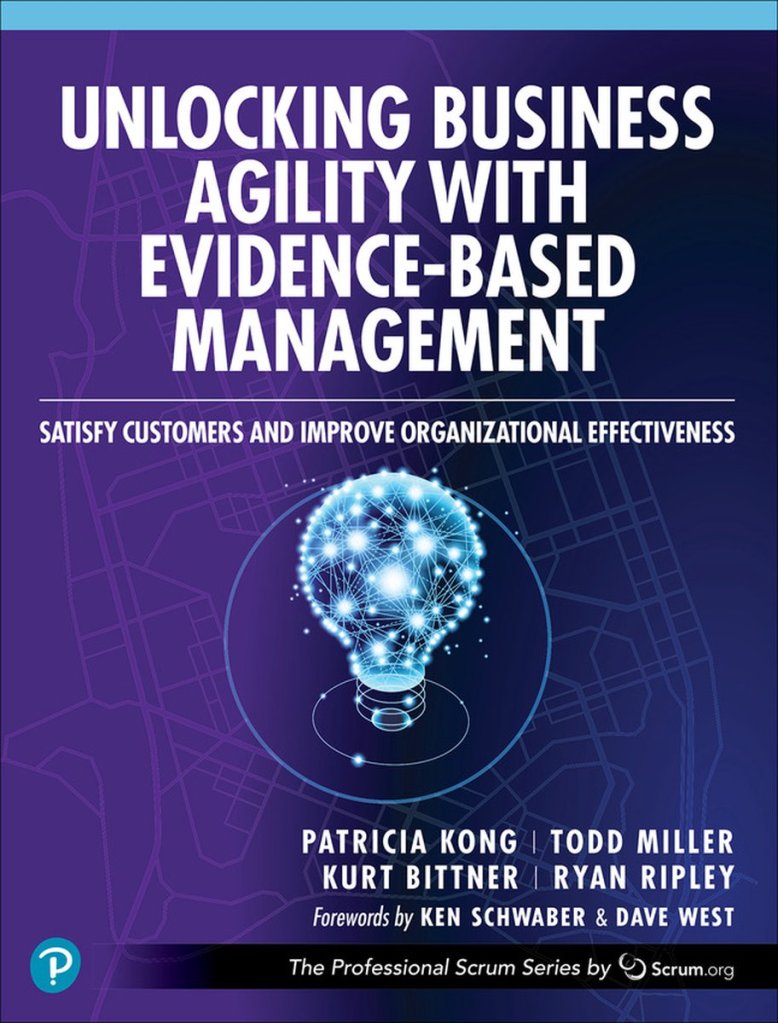
In Unlocking Business Agility with Evidence-Based Management – Satisfy customers and improve organizational effectiveness, authors Patricia Kong, Todd Miller, Kurt Bittner, and Ryan Ripley use the framework Evidence-Based Management (EBM). EBM is an empirical approach that helps organizations use experimentation and rapid feedback to progress towards goals.
According to the authors, the purpose of this book is to help organizations find their true purpose, improve their ability to reach their goals, and build a culture of trust and transparency that allows them to learn from their experiences.
EBM
The book starts with a brief introduction to EBM. EBM talks about three levels of goals: strategic, intermediate, and immediate tactical goals. Organizations must run experiments that involve forming hypotheses intended to advance them toward their current intermediate goal and use the evidence they obtain to evaluate their goals and determine their next steps to advance toward these goals. Along with goals and the experiment loop, EBM introduces four key value areas (current value, unrealized value, time-to-market, ability to innovate) that organizations use to consider what value they are delivering and could pursue, as well as their ability to do so.
Purpose
The first chapter shows how organizations must find purpose by looking through the eyes of their customers, why strategic goals should be focused on improving customer outcomes, and how measurement provides feedback that organizations need to adapt their goals and strategies. Understanding and bridging the customer’s satisfaction gap – the difference between the customer’s current experience and their desired experience – is key. The cases as provided in all chapters help to understand.
Value
The second chapter shows that having strategic goals isn’t enough. A company that does not measure the value it delivers to its customers simply flies blind, hoping that it guesses and preconceptions lead to business success. You need an experiment loop (hypothesis, experiment & measure, inspect and adapt) to move from your current state towards your next immediate tactical goal while aligning with the strategic goal. Goals can change because of outside events, and you may need to reconsider and revise your tactics to reach your goals.
Customer feedback
In the following chapter the focus is on improving time to market by getting better information faster about what customers need. Faster delivery means more frequent and relevant customer feedback. Besides speed, the effectiveness of an organization to deliver new capabilities that might better meet customer needs, is important too (ability to innovate).
Expectations
Next managing and overcoming expectations are in the spotlights. It is about teams or people being unable to speak to their reality without fear of retribution or negative judgement. Some common expectations that you run into all the time, but you must let go of, are:
- Maximizing output maximizes value.
- Maximizing efficiency maximizes value.
- Internal stakeholders know what customers want.
- The ‘business’ is the customer.
- Going fast is all that matters.
- Adding more people saves a project.
- Predictability is a paramount goal.
- Sunk cost matters.
Noise
It is not enough to identify measures and goals once and move on. You must constantly evaluate the usefulness of both your goals and what you are measuring. Your goals, what and how you measure will change and evolve as your products and customers change and evolve. You must look for the right signals and damp the noise. Noise is data that is irrelevant to your decision. Some areas of focus that add to the noise rather than dampen it, are utilization, capacity, velocity, productivity, misguided quality metrics, budget, and time. Bias is another source that creates noise. E.g. confirmation bias, anchoring bias, availability bias, overconfidence bias, groupthink, and sunk cost fallacy.
Apply EBM
The final chapters show how to apply EBM at product (one product), portfolio (multiple products), and organizational Level. Replace false certainty with experimentation and use strategic goal mapping to form experiments. Strategic goal mapping is a technique that helps organizations connect a strategic goal with intermediate goals, personas, desired outcome, immediate tactical goals to discover experiments.
Organizations could narrow down their options by considering the smallest possible experiments they could run to determine if an initiative is worth pursuing. For an organization, a hypothesis is a bet on value. To manage a basis quarterly cycle of portfolio-level experiments: define & refine goals, examine & abandon excess WIP, propose experiments, evaluate proposals, run experiments, evaluate progress towards goals – define & refine goals – …
If an organization wants to change it needs to consider if it wants to truly morph into a version of itself that is more likely to sustain in the future. It must understand where they are today and give their people a “why” and empower their teams by inverting the organization.
In summary, this book is excellent for gaining insights into business agility. By examining various examples and understanding the lessons derived from applying the Evidence-Based Management framework, it becomes a crucial read.
To order Unlocking Business Agility with Evidence-Based Management: managementboek, bol.















